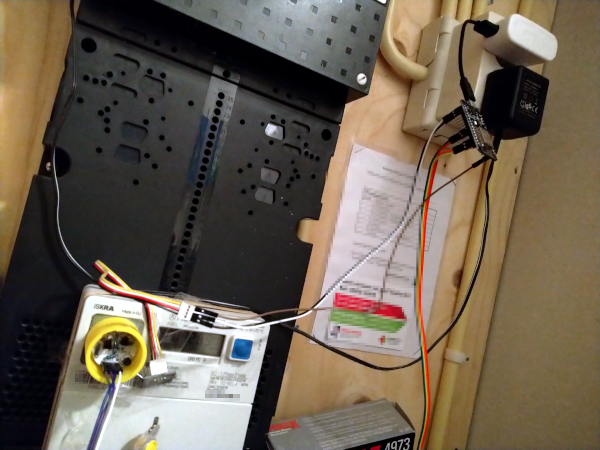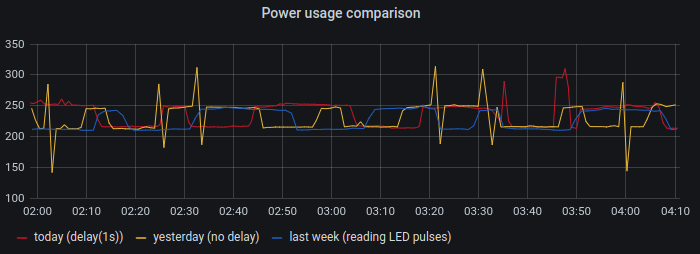Project Energy 32: Read electricity meter (ISKRA ME162), through optical port, export power usage using MQTT.
This project contains C code to read values from the ISKRA ME-162 electricity meter using an ESP8622 (or Arduino) and push them to an MQTT broker.
(There is also a Python version of this project at pe32me162irpy_pub.)
Features:
- Although the ISKA ME162 does not include power readouts (in Watt), we query the total energy consumed/produced (in Watt-hour) every second or so. This allows us to get a fair estimate of instantanous power usage. This can in fact give a better estimate than just sampling instantaneous power every now and then (which would be possible on other meters).
Required hardware: a so-called optical probe.
2023 - Bret McGee offers pre-soldered optical probes at ebay UK. You'll likely want to 3D print a plastic cover with magnets for easy attachment to your meter.
(I've been told Aalborg hackers stopped shipping their packages: "Bemærk: Vi sælger ikke længere kits.")
2021 - On the Hal9k Kamstrup Project page (by Aalborg hackers) you can find instructions to build an optical probe (infrared transceiver) to communicate with Kamstrup electricity meters using the optical communications port. Such an optical communication port is available on several other electricity meters, like the ISKRA ME-162 commonly found in the Netherlands. This optical probe can also be used on those.
First, you order the soldered probe from Bret on ebay UK and 3D print the cover.
BEWARE: If you're doing a solder based on the Kamstrup images, know that the images on their page actually have the two BC547 transistors depicted in reverse. If you look at the diagram, you'll find they should be rotated 180 degrees, with the Collectors connected to the 10k resistors.
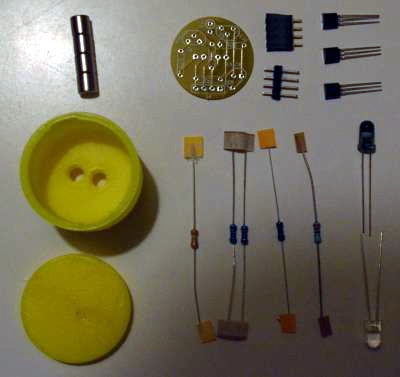
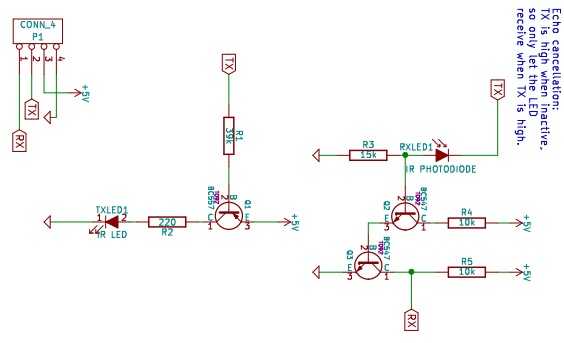
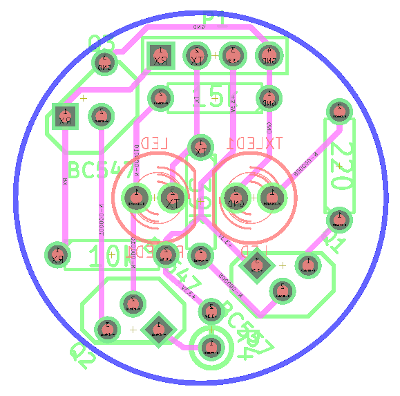
(the PCB, as seen from the bottom)
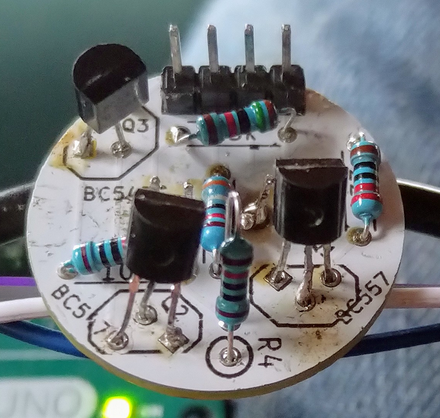
(my shabby soldering, with the BC547s turned the right way)
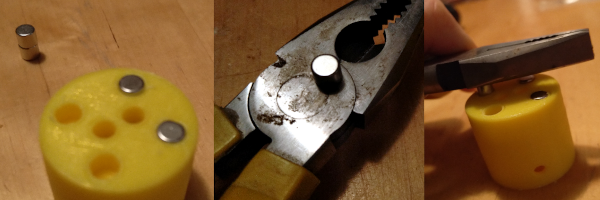
(gently inserting the magnets into the plastic shell, after widening the openings a bit)
Second, you test that the infrared transmitter works, by attaching it to an Arduino or similar, and running something like this:
const int PIN_TX = 10; const int PIN_LED = 13; int val = LOW; void setup() { pinMode(PIN_TX, OUTPUT); pinMode(PIN_LED, OUTPUT); } void loop() { val = (val == LOW) ? HIGH : LOW; digitalWrite(PIN_TX, val); digitalWrite(PIN_LED, val); delay(1000); }
This causes the Arduino LED and the TX LED to take turns lighting up. Because the TX LED will be off when the TX PIN is high.
When you look at the infrared LED with a digital photo camera (on your phone), you should be able to see the light as pink. (You can confirm that your camera sees it by looking at a TV remote control when it's transmitting.)
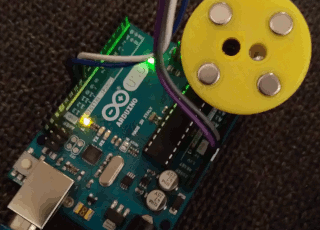
Third, you check that the infrared reception works. Run the following code:
const int PIN_RX = 9; const int PIN_TX = 10; const int PIN_LED = 13; void setup() { pinMode(PIN_RX, INPUT); pinMode(PIN_TX, OUTPUT); pinMode(PIN_LED, OUTPUT); // TX must be HIGH (=no transmitted light), or RX will always // be HIGH (=no light reception). digitalWrite(PIN_TX, HIGH); digitalWrite(PIN_LED, HIGH); } void loop() { int val = digitalRead(PIN_RX); // Daylight or a bright lamp makes the Arduino LED go out. // Alternately, reception of a TV remote control infrared light // will cause visible flicker of the Arduino LED. if (val == LOW) { digitalWrite(PIN_LED, LOW); delay(50); } else { digitalWrite(PIN_LED, HIGH); } }
When the RX photo transistor receives (infrared, but also other) light, the RX PIN will be pulled low. The sketch will pull the LED PIN low: LED off. (And vice versa: no IR light causes the LED to turn on.)
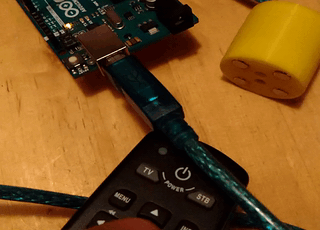
When you have completed the above steps, you should be able to hook it up to your electricity meter. Check the comments at the top of the pe32me162ir_pub.ino source file for PIN details and configuration.
After hooking everything up, your meter cupboard might look like this:
At the moment, the MQTT messages will look as follows.
Initial publish after device startup:
device_id=EUI48:11:22:33:44:55:66&id=ISK5ME162-0033&DATA= C.1.0(47983850)\r\n0.0.0(47983850)\r\n1.8.0(0033271.483*kWh)\r\n 1.8.1(0000000.000*kWh)\r\n1.8.2(0033271.483*kWh)\r\n 2.8.0(0000007.784*kWh)\r\n2.8.1(0000000.000*kWh)\r\n 2.8.2(0000007.784*kWh)\r\nF.F(0000000)\r\n!\r\n
Consecutive publishes look like:
device_id=EUI48:11:22:33:44:55:66& e_pos_act_energy_wh=33271493&e_neg_act_energy_wh=7784& e_inst_power_w=1397&dbg_uptime=31267
Where the keys mean:
- e_pos_act_energy_wh (1.8.0) = Positive active energy [Wh]
- e_neg_act_energy_wh (2.8.0) = Negative active energy [Wh]
- e_inst_power_w (16.7.0) = Sum of active instantaneous power [Watt]
For testing/compiling while developing, we use the bogoduino submodule:
$ git submodule init Submodule 'bogoduino' (https://github.com/wdoekes/bogoduino.git) registered for path 'bogoduino' $ git submodule update Cloning into 'pe32me162ir_pub/bogoduino'... Submodule path 'bogoduino': checked out '7bec2a5'
Now you can run make to run some test code:
$ make ./pe32me162ir_pub.test OK (cescape): """a""" ...
(Note, the following issue was only relevant up until commit d844533.
After that commit, visible LED pulses are not that important because we
query the meter for totals every second. You'd now need to enable
OPTIONAL_LIGHT_SENSOR for this functionality.)
Occasionally, we would see these odd spikes:
+34.0 16:00:53 {'e_pos_act_energy_wh': 32917428, 'e_inst_power_w': 428, 'dbg_uptime': 6807478, 'dbg_pulse': '1..101'}
+34.0 16:01:27 {'e_pos_act_energy_wh': 32917432, 'e_inst_power_w': 428, 'dbg_uptime': 6841062, 'dbg_pulse': '1..133'}
+33.0 16:02:00 {'e_pos_act_energy_wh': 32917437, 'e_inst_power_w': 535, 'dbg_uptime': 6874655, 'dbg_pulse': '1..111'}
+34.0 16:02:34 {'e_pos_act_energy_wh': 32917440, 'e_inst_power_w': 321, 'dbg_uptime': 6908240, 'dbg_pulse': '1..171'}
+33.0 16:03:07 {'e_pos_act_energy_wh': 32917444, 'e_inst_power_w': 427, 'dbg_uptime': 6941936, 'dbg_pulse': '1..192'}
+34.0 16:03:41 {'e_pos_act_energy_wh': 32917448, 'e_inst_power_w': 427, 'dbg_uptime': 6975619, 'dbg_pulse': '1..161'}
+34.0 16:04:15 {'e_pos_act_energy_wh': 32917452, 'e_inst_power_w': 429, 'dbg_uptime': 7009170, 'dbg_pulse': '1..157'}
+33.0 16:04:48 {'e_pos_act_energy_wh': 32917457, 'e_inst_power_w': 536, 'dbg_uptime': 7042692, 'dbg_pulse': '1..118'}
+34.0 16:05:22 {'e_pos_act_energy_wh': 32917460, 'e_inst_power_w': 321, 'dbg_uptime': 7076275, 'dbg_pulse': '1..174'}
+34.0 16:05:56 {'e_pos_act_energy_wh': 32917464, 'e_inst_power_w': 424, 'dbg_uptime': 7110158, 'dbg_pulse': '1..133'}
+36.0 16:06:32 {'e_pos_act_energy_wh': 32917468, 'e_inst_power_w': 395, 'dbg_uptime': 7146556, 'dbg_pulse': '1..134'}
That is, at 16:02:00, there appears to be a Wh value too many (+5
instead of +4) which is compensated for at 16:02:34 (+3 instead of
+4). And, again at 16:04:48 and 16:05:22. Instead of 535 and 321
Watt, we'd expect 423 and 436 Watt.
These always appear to be early counts, not late ones.
A possible cause could be that we're always getting a value too early: if the LED pulse is sent before the Wh is counter is incremented, we might "normally" get a pulse too little, and only sometimes we'd get the right value (i.e. one more).
The above graph initially seemed to disprove that theory, but after increasing the delay to a full second, the spikes disappeared.
Now the new graph is more in line with the "old" counter (which was still in use last week) which read the LED pulses to indicate power consumption.
Project energy 32 is a suite of personal home readout/automation tools. Batteries are not included. You need to set up an MQTT broker, a database to store the readouts, a backend that subscribes and inserts the values, vacuuming/pruning code, and something to display the values (like Grafana).
